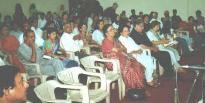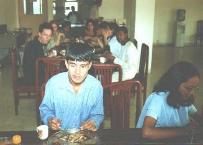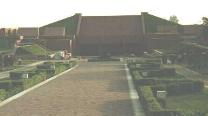Bahá'í Volunteers needed at Mashriqu'l-Adhkár in India.
I have recently returned from a round trip including a 9-day pilgrimage and 2½ weeks with a Bahá'í family in New Delhi.
When my plans were being made, I had a very different idea of service to what actually happened. Being the only Bahá'í in my family, with 4 grandchildren to help look after, any idea of a travel teaching trip abroad is out of the question. However, all the family know of the requirement for me to go on pilgrimage, they knew that I had applied 6 years ago and were fully supportive of me accepting when the dates came through. Having 18 months before my selected date gave me plenty of time to prepare the family for my time away to be somewhat longer than 9 days. I had in mind some travel teaching, but phrased it for the family as "practical service to follow up the spiritual experience of pilgrimage". The fact that my offer of accommodation was made by someone who used to live near us and was known to the family was a great help. We had some laughs at my desire to "stop at New Delhi on the way home", since from Tel Aviv to New Delhi is just about in the opposite direction to home! So the family agreed and my flights were booked. I took appropriate materials for giving talks at public meetings and firesides, being involved with travel teaching in India, and helping teachers with children's classes. It had been explained to me that any spare time could be spent helping at the Mashriqu'l-Adhkár but we had not discussed the nature of help required there.
It was a valuable experience to be involved in a very large Bahá'í
community. There are over a thousand Bahá'ís in Delhi, although most of them
don't get to many meetings; even so, to have over a hundred at a 19-day Feast
(see photo) was very interesting. It means that the way Feasts and other meetings are
conducted is quite different to what I am used to in UK. The challenges involved
were a good indication of what we will face in due course when we have entry by
troops here. One way in which they are aiming to meet these challenges is by
having a good study circle programme using the Ruhi Institute books, and some
people are just completing book 7. This underlines the need in UK for as many
people as possible to attend study circles before we have to meet the challenges
of large meetings. My materials for talks were not used, since a good translator
into Hindi was not readily available and the people who would benefit from my
talks did not have a sufficient command of English.
There are over a thousand Bahá'ís in Delhi, although most of them
don't get to many meetings; even so, to have over a hundred at a 19-day Feast
(see photo) was very interesting. It means that the way Feasts and other meetings are
conducted is quite different to what I am used to in UK. The challenges involved
were a good indication of what we will face in due course when we have entry by
troops here. One way in which they are aiming to meet these challenges is by
having a good study circle programme using the Ruhi Institute books, and some
people are just completing book 7. This underlines the need in UK for as many
people as possible to attend study circles before we have to meet the challenges
of large meetings. My materials for talks were not used, since a good translator
into Hindi was not readily available and the people who would benefit from my
talks did not have a sufficient command of English. I did help with a children's
class once, when the teacher did not turn up, but progress was slow since the
older children had to translate into Hindi for the younger children. The Delhi
community has a large property called Bahá'í House with two buildings and
extensive lawns, which serves as both a National Haziratu'l-Quds and a local
Bahá'í Centre. All
Feasts and Holy Day meetings start early and are followed by dinner, which is
prepared by groups of families on a voluntary rota basis. Most of the year the
weather is suitable for the dinner to be served outside, which means that there
is plenty of space for socialising, even when Bahá'ís from other parts of
India, and invited guests, bring the total for a Holy Day celebration to over
200.
My hostess took me to the Temple, which is known locally as the Lotus Temple,
and introduced me to some of the staff. I got some idea of what was to come when
we had to make our way through hordes of people coming and going along the
approach path. In the library it was much quieter, with half a dozen people
browsing the books and leaflets, which are available in just about any language
of the world. In due course I had a briefing by the organiser of the volunteers,
who was in no doubt that I would be able to cope with any visitor questions, but
would I at my age be able to stand up all day? (There was an alternative of
service in the library.) I assured her that 9 days of walking and climbing steps
on pilgrimage had made me fit for anything, so I was allocated a rota like most
of the other volunteers. For my 5 days of service I started by having breakfast
and briefing/deepening with the volunteers between 8-15 and 9-15 a.m. Then we
were at our posts by the time the first visitors arrived. The Temple is open
from 9-30 a.m. to 5-30 p.m. in the winter months, every day except Monday. There
were about 15 volunteers on duty, divided into 3 groups.
At the entrance one normally opens the door to let a group of people in, then
closes it quietly before another explains to the next group (normally in Hindi
& English, but sometimes in another language if there is a party from the
country of one of the volunteers) about the silence required inside, no
photographs, and information available on the way out. During peak times the
door needs to be held open and the explanation repeated continuously to the
moving queue. At 4 times of day there is a short service, about 12 minutes, and
further explanation is needed so that people only enter if they have that time
available, since although visitors are allowed in during the service, they are
expected to find seats quickly and the exit door is shut until the service has
finished. A 3rd volunteer has a counter to click for every person who enters,
while a 4th is needed at busy times to organise the visitors into a single line
as they approach. From time to time a large school party arrives, having had
explanations in a briefing hall in advance, and a 5th volunteer obtains the
number of people from the teacher in charge and opens a separate door for them
to enter.
Since there are many different Indian languages, and not all Indians
understand Hindi, plus the fact that at busy times one cannot ensure that
everybody is listening as they walk past, there is often a requirement to help
maintain silence in the Temple, especially by the elderly and the younger
visitors. Putting one's hands together at face level and giving a slight bow
usually gets immediate attention and then a finger on closed lips is understood.
Volunteers inside spread themselves around, with at least one by the entrance,
and keep vigilant for the source of any noise. When the visitors are sparse, and
during services, it is appropriate for some of them to have a turn at sitting on
the marble benches. During services, the exit door is closed, so
volunteers on duty there can relax for a few minutes, as seen in this
picture. On one occasion, during a service, a baby would not stop
crying out, despite his mother's efforts; as there was an empty bench behind,
and he was held over her shoulder, I sat down behind him and just gave him a big
smile, to which he responded with a smile and stopped crying for the remaining
few minutes of the service.
 The 3rd group of volunteers, holding leaflets, form a row a short distance
from the exit door. As people come out they are invited, in Hindi & English,
to take information. Those who approach us are asked "language?", and
normally accept a Hindi or English leaflet. Often there are family groups
requiring Bengali, so I carried leaflets in those 3 languages. Other volunteers
had learnt to recognise about a dozen Indian languages and held some of each. A
rack by the door contained further supplies and occasionally a coach would have
arrived with many people requiring a particular language, then one volunteer
would get a large quantity for them. Anyone from another country not
understanding English is directed to the library for their leaflet. Quite often
visitors ask for more information than is in the leaflet and volunteers answer
all sorts of questions for a short time; to be fair on the other visitors
exiting, anyone requiring very detailed answers are directed to the library or
the exhibition & information centre, where postcards and books etc. may be
purchased.
The 3rd group of volunteers, holding leaflets, form a row a short distance
from the exit door. As people come out they are invited, in Hindi & English,
to take information. Those who approach us are asked "language?", and
normally accept a Hindi or English leaflet. Often there are family groups
requiring Bengali, so I carried leaflets in those 3 languages. Other volunteers
had learnt to recognise about a dozen Indian languages and held some of each. A
rack by the door contained further supplies and occasionally a coach would have
arrived with many people requiring a particular language, then one volunteer
would get a large quantity for them. Anyone from another country not
understanding English is directed to the library for their leaflet. Quite often
visitors ask for more information than is in the leaflet and volunteers answer
all sorts of questions for a short time; to be fair on the other visitors
exiting, anyone requiring very detailed answers are directed to the library or
the exhibition & information centre, where postcards and books etc. may be
purchased.
 Volunteers have an hour for lunch and two 15 minute tea breaks, on a rota.
One gets quite used to the hot, sweet, milky tea, which is served in a small
staff area under the approach steps. Meals are served in the accommodation
block, which is at the far side of the gardens. The gate into the gardens is
closed at 5-30 p.m., but by the time the last of them have walked through the
gardens it is nearly 6 p.m., getting dark and the Temple lights are on. Some of
the volunteers choose to have their own service before going back for dinner at
6-30 p.m. The acoustics in the Temple are amazing! When speaking, chanting or
singing at the microphones, it is necessary to leave gaps between words and
enunciate very clearly, for the echoes of sounds take up to 2 seconds to die
away. I participated in the volunteers' service once, but normally went quickly
to get my transport home before it got completely dark. At the main gate there
are rickshas waiting, which are small 3-wheeler open-sided vehicles powered by
motor cycle engines. You are advised to negotiate the fare in advance and I
normally travelled the 12 minute journey for 20 rupees, = 30 pence!
Volunteers have an hour for lunch and two 15 minute tea breaks, on a rota.
One gets quite used to the hot, sweet, milky tea, which is served in a small
staff area under the approach steps. Meals are served in the accommodation
block, which is at the far side of the gardens. The gate into the gardens is
closed at 5-30 p.m., but by the time the last of them have walked through the
gardens it is nearly 6 p.m., getting dark and the Temple lights are on. Some of
the volunteers choose to have their own service before going back for dinner at
6-30 p.m. The acoustics in the Temple are amazing! When speaking, chanting or
singing at the microphones, it is necessary to leave gaps between words and
enunciate very clearly, for the echoes of sounds take up to 2 seconds to die
away. I participated in the volunteers' service once, but normally went quickly
to get my transport home before it got completely dark. At the main gate there
are rickshas waiting, which are small 3-wheeler open-sided vehicles powered by
motor cycle engines. You are advised to negotiate the fare in advance and I
normally travelled the 12 minute journey for 20 rupees, = 30 pence!
 Bahá'ís who volunteer for at least a month have meals and accommodation
provided in 2 modern blocks (behind the conference hall in this photo), sharing from 2 to 4 per room. The maximum time is 3
months. They come from all over the world and are mainly youth, some of whom
have only recently declared. The deepening sessions help them to answer
questions by visitors and improve their knowledge of English but, whereas they
are very dedicated and manage extremely well, visitors from an English-speaking
country were often very pleased to find someone whose first language was
English, and I was the only one there. So here is a challenge, particularly for
UK Bahá'í youth, but also for any Bahá'í over 18 with a month or two to spare; apply to be a volunteer at the Indian Temple, you will be giving a great service to the Cause and will benefit yourself by the spiritual atmosphere of the Temple. The average number of visitors per day for October was over 21,000 and CNN recently did a ½ hour programme on the Temple in which they said that it is now the top tourist attraction of the whole world!
Bahá'ís who volunteer for at least a month have meals and accommodation
provided in 2 modern blocks (behind the conference hall in this photo), sharing from 2 to 4 per room. The maximum time is 3
months. They come from all over the world and are mainly youth, some of whom
have only recently declared. The deepening sessions help them to answer
questions by visitors and improve their knowledge of English but, whereas they
are very dedicated and manage extremely well, visitors from an English-speaking
country were often very pleased to find someone whose first language was
English, and I was the only one there. So here is a challenge, particularly for
UK Bahá'í youth, but also for any Bahá'í over 18 with a month or two to spare; apply to be a volunteer at the Indian Temple, you will be giving a great service to the Cause and will benefit yourself by the spiritual atmosphere of the Temple. The average number of visitors per day for October was over 21,000 and CNN recently did a ½ hour programme on the Temple in which they said that it is now the top tourist attraction of the whole world!
If you are a Bahá'í and think that you could volunteer, send for
further information to your National Bahá'í Centre.
[This report was written in November 2001.]
or click pilgrimage to see other pages about my time in Israel.